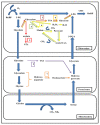Improving Crop Yield through Increasing Carbon Gain and Reducing Carbon Loss
- PMID: 38794389
- PMCID: PMC11124956
- DOI: 10.3390/plants13101317
Improving Crop Yield through Increasing Carbon Gain and Reducing Carbon Loss
Abstract
Photosynthesis is a process where solar energy is utilized to convert atmospheric CO2 into carbohydrates, which forms the basis for plant productivity. The increasing demand for food has created a global urge to enhance yield. Earlier, the plant breeding program was targeting the yield and yield-associated traits to enhance the crop yield. However, the yield cannot be further improved without improving the leaf photosynthetic rate. Hence, in this review, various strategies to enhance leaf photosynthesis were presented. The most promising strategies were the optimization of Rubisco carboxylation efficiency, the introduction of a CO2 concentrating mechanism in C3 plants, and the manipulation of photorespiratory bypasses in C3 plants, which are discussed in detail. Improving Rubisco's carboxylation efficiency is possible by engineering targets such as Rubisco subunits, chaperones, and Rubisco activase enzyme activity. Carbon-concentrating mechanisms can be introduced in C3 plants by the adoption of pyrenoid and carboxysomes, which can increase the CO2 concentration around the Rubisco enzyme. Photorespiration is the process by which the fixed carbon is lost through an oxidative process. Different approaches to reduce carbon and nitrogen loss were discussed. Overall, the potential approaches to improve the photosynthetic process and the way forward were discussed in detail.
Keywords: CO2 concentrating mechanism; Rubisco; photorespiration; photosynthesis.
Conflict of interest statement
The authors declare no conflicts of interest.
Figures
References
-
- Department of Economic and Social Affairs Population Division, United Nations . World Population Prospects 2022. United Nations; New York, NY, USA: 2022.
-
- Yuan S., Nie L., Wang F., Huang J., Peng S. Agronomic performance of inbred and hybrid rice cultivars under simplified and reduced-input practices. Field Crop. Res. 2017;210:129–135. doi: 10.1016/j.fcr.2017.05.024. - DOI
-
- Shivanna K. Climate change and its impact on biodiversity and human welfare. Proc. Indian Natl. Sci. Acad. 2022;88:160–171. doi: 10.1007/s43538-022-00073-6. - DOI
Publication types
LinkOut - more resources
Full Text Sources
Miscellaneous


